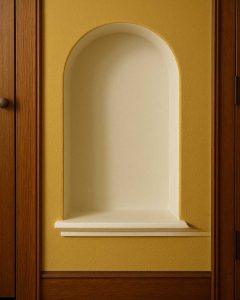When I bought my charming older home three years ago, I was instantly drawn to its unique personality and undeniable historical appeal. The creaky hardwood floors, arched doorways, and original crown molding all spoke to a different era—a time when craftsmanship was king and homes were built with character. But despite all its delightful quirks, there was one particular feature that completely baffled me: a three-foot-tall recessed nook in the hallway. It wasn’t quite deep enough to function as a closet, definitely not the right shape for a bookshelf, and far too awkward to be used as a display area for something like a tall plant or vase. It stood there, oddly placed and seemingly without purpose, as if it had been forgotten by time.

This unusual little alcove quickly became a subject of curiosity among visitors. Whenever friends or family came over, they’d ask about it. “What’s that for?” was a common question. Everyone had a theory—some thought it was for a statue, others guessed a mail station or even a secret cupboard. But nothing truly made sense. The mystery nagged at me, especially because everything else in the home had a story or a purpose. I began researching and combing through historical documents, curious to know more about the house’s origins. That’s when I discovered that what I assumed was a bizarre design choice was actually a thoughtful, intentional feature common in mid-20th-century homes.
To understand the purpose of this strange architectural detail, you have to look at the time period when the house was built. In the 1950s and 1960s, suburban homes were being constructed for the booming middle class, and family life revolved around togetherness and structured routines. Rotary telephones were an essential household tool, and communication was more deliberate than it is today. There was no texting, emailing, or messaging apps. Every phone call required time and attention, so homes were designed with that in mind. Enter the phone nook.
Back in those days, homes were often built with a specific area for the family telephone. These phone nooks were purposefully placed in central spots like hallways or just off the living room, where everyone in the house could easily access them. Typically, they included a small shelf or ledge to hold the rotary phone, a nearby power outlet, and sometimes even a tiny built-in bench or seat. These nooks weren’t just functional—they were also part of the home’s aesthetic, blending seamlessly into the architecture while providing a hub for household communication. It’s hard to imagine now, but back then, it made perfect sense. In an era before cordless phones or smartphones, the telephone was tethered to a wall, and having a designated space for it was essential.
This small nook wasn’t just a place to make calls—it was a mini social center. Families would gather around it when the phone rang. Teenagers would lean against the wall, whispering secrets to their friends. Parents coordinated carpools, doctor appointments, and dinner plans. Someone might even leave a notepad nearby to jot down messages or write in a phone directory. The inclusion of a nearby chair or bench told you something else: phone calls were meant to be enjoyed, not rushed. Conversations were important, and the home’s layout reflected that.
But like many relics of the past, phone nooks lost their relevance as technology advanced. As mobile phones, cordless handsets, and Wi-Fi took over, the once-essential phone nook became obsolete. Suddenly, people could talk on the phone while walking around, sitting outside, or cooking in the kitchen. There was no longer any need for a fixed communication spot in the hallway. And that’s how I ended up with a beautiful but useless little niche that puzzled me for years.
So, what does one do with an architectural oddity like this in the 21st century? The answer lies in creativity and adaptation. Some homeowners have reimagined their phone nooks into charming little bookshelves, adding narrow shelves to house their favorite novels or vintage décor. Others have leaned into the tech-forward world and transformed their nooks into charging stations for tablets and phones—adding USB ports, hooks for cords, and even small drawers for organizing devices. I’ve seen a few that were turned into stylish mini-bars with glass shelves and LED lighting, and others used them as photo galleries to display framed family memories.
In my case, I decided to turn the nook into a cozy reading corner. I added a tiny stool, a few soft cushions, and installed a sconce above it for lighting. I keep a stack of my favorite paperbacks and a small potted plant on the ledge. It’s become a peaceful little sanctuary where I can pause, breathe, and escape into a story for a few minutes every day. While the nook no longer serves its original purpose, it now has a meaningful place in my daily life, which feels like a respectful tribute to the home’s past.
Living in an older house comes with its own set of surprises—some delightful, others perplexing. But one of the greatest joys is uncovering the stories that lie within its walls. That little hallway nook once held the heart of communication in a mid-century family home. While it may no longer be necessary in today’s world, repurposing it has allowed me to honor the past while embracing the present. In doing so, I’ve learned that the real beauty of older homes isn’t just in their aesthetics but in the layers of life they represent. These small quirks, like a forgotten phone nook, are reminders that homes evolve, just like the people who live in them.





